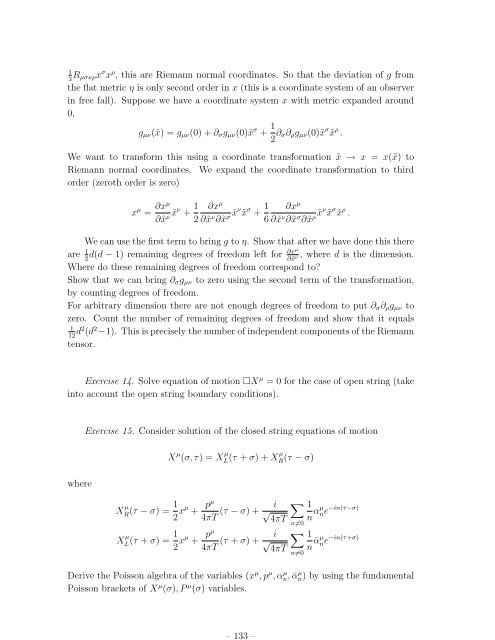Lectures on String Theory
Lectures on String Theory
Lectures on String Theory
Create successful ePaper yourself
Turn your PDF publications into a flip-book with our unique Google optimized e-Paper software.
– 133 –<br />
1<br />
R 3 µσνρx σ x ρ , this are Riemann normal coordinates. So that the deviati<strong>on</strong> of g from<br />
the flat metric η is <strong>on</strong>ly sec<strong>on</strong>d order in x (this is a coordinate system of an observer<br />
in free fall). Suppose we have a coordinate system x with metric expanded around<br />
0,<br />
g µν (˜x) = g µν (0) + ∂ σ g µν (0)˜x σ + 1 2 ∂ σ∂ ρ g µν (0)˜x σ ˜x ρ .<br />
We want to transform this using a coordinate transformati<strong>on</strong> ˜x → x = x(˜x) to<br />
Riemann normal coordinates. We expand the coordinate transformati<strong>on</strong> to third<br />
order (zeroth order is zero)<br />
x µ = ∂xµ<br />
∂˜x ν ˜xν + 1 ∂x µ<br />
2 ∂˜x ν ∂˜x σ ˜xν ˜x σ + 1 ∂x µ<br />
6 ∂˜x ν ∂˜x σ ∂˜x ρ ˜xν ˜x σ ˜x ρ .<br />
We can use the first term to bring g to η. Show that after we have d<strong>on</strong>e this there<br />
are 1 ∂xµ<br />
d(d − 1) remaining degrees of freedom left for , where d is the dimensi<strong>on</strong>.<br />
2 ∂˜x ν<br />
Where do these remaining degrees of freedom corresp<strong>on</strong>d to?<br />
Show that we can bring ∂ σ g µν to zero using the sec<strong>on</strong>d term of the transformati<strong>on</strong>,<br />
by counting degrees of freedom.<br />
For arbitrary dimensi<strong>on</strong> there are not enough degrees of freedom to put ∂ σ ∂ ρ g µν to<br />
zero. Count the number of remaining degrees of freedom and show that it equals<br />
1<br />
12 d2 (d 2 −1). This is precisely the number of independent comp<strong>on</strong>ents of the Riemann<br />
tensor.<br />
Exercise 14. Solve equati<strong>on</strong> of moti<strong>on</strong> □X µ = 0 for the case of open string (take<br />
into account the open string boundary c<strong>on</strong>diti<strong>on</strong>s).<br />
where<br />
Exercise 15. C<strong>on</strong>sider soluti<strong>on</strong> of the closed string equati<strong>on</strong>s of moti<strong>on</strong><br />
X µ (σ, τ) = X µ L (τ + σ) + Xµ R<br />
(τ − σ)<br />
X µ R (τ − σ) = 1 2 xµ + pµ<br />
(τ − σ) +<br />
i<br />
4πT<br />
∑<br />
√<br />
4πT<br />
n≠0<br />
n≠0<br />
1<br />
n αµ ne −in(τ−σ)<br />
X µ L (τ + σ) = 1 2 xµ + pµ<br />
(τ + σ) +<br />
i ∑<br />
√ nᾱµ 1<br />
4πT<br />
ne −in(τ+σ)<br />
4πT<br />
Derive the Poiss<strong>on</strong> algebra of the variables (x µ , p µ , α µ n, ᾱ µ n) by using the fundamental<br />
Poiss<strong>on</strong> brackets of X µ (σ), P µ (σ) variables.

















